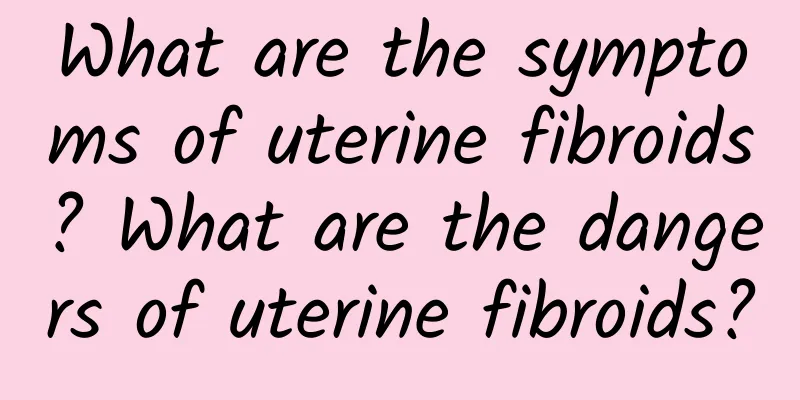What are the symptoms of uterine fibroids? What are the dangers of uterine fibroids?

|
Symptoms of uterine fibroids: 1. Uterine bleeding: occurs in half or more of the patients. The main manifestations are menorrhagia, prolonged menstruation or shortened menstrual cycle, accounting for about 2/3; continuous or irregular bleeding accounts for 1/3. Bleeding is mainly caused by intramural fibroids and submucosal fibroids. Intramural fibroids have periodic bleeding, while submucosal fibroids often show irregular bleeding. Subserosal fibroids rarely cause uterine bleeding, but in some cases, the amount of menstruation decreases. 2. Abdominal mass: The patient touches the abdominal mass by himself, mainly after the uterine fibroids grow out of the pelvic cavity, usually in the early morning when the bladder is full on an empty stomach. Because the uterus and fibroids are pushed up, the patient can easily touch it, and the uterus can be more than 4 to 5 months pregnant, and the bladder is also full. Uterine fibroids are generally located in the middle of the lower abdomen, and a few people can be biased to the lower abdomen, hard or uneven. Most people are degenerate, soft and smooth. Most of them do not grow fast. Few people can grow faster or with hidden pain, and malignant changes should be suspected. 3. Pain: Pain is caused by the tumor compressing the pelvic blood vessels, causing blood stasis, or compressing the nerves, or submucosal fibroids can stimulate uterine contraction, and the cervical canal widening pain caused by discharge from inside and outside the uterus; or fibroid necrosis infection caused by pelvic inflammation, adhesions, traction, etc. If some people have severe abdominal pain and fever due to the red degeneration of uterine fibroids. Torsion of the pedicle of subserosal fibroids or torsion of the uterine axis can also cause acute and severe abdominal pain. Large subserosal fibroids grow in wide ligaments, which not only compress nerves and blood vessels to cause pain, but also compress the ureters to cause ureteral or renal hydrops, causing low back pain. Severe dysmenorrhea and sexual pain are often caused by uterine fibroids and adenomyosis or endometriosis. 4. Compression symptoms: mainly occur in cervical fibroids, or fibroids in the lower part of the uterus that enlarge and fill the pelvic cavity, compressing the surrounding organs. Compression of the bladder, frequent urination or difficulty urinating, urinary retention, etc.; compression of the ureter can cause hydronephrosis and pyelitis. Fibroids growing on the posterior wall of the uterus can compress the rectum, leading to constipation and even difficulty in defecation. Pelvic venous pressure can cause lower limb edema. Compression symptoms are more obvious in the early stages of menstruation, which is the reason for the congestion and swelling of uterine fibroids. If subserosal fibroids are embedded in the uterine rectal fossa, bladder or rectal compression symptoms will also occur. 5. Increased leucorrhea: Increased uterine cavity, increased endometrial glands, pelvic congestion or inflammation can increase leucorrhea; when submucosal fibroids ulcerate, infect, bleed, or necrotize, a large amount of bloody or purulent leucorrhea will be produced. The above symptoms of uterine fibroids are relatively common, and we need to actively grasp them. Of course, in order to ensure everyone's health, we must actively consult relevant experts to obtain accurate treatment methods. |
<<: What fruits can relieve uterine fibroids? What is the best food for uterine fibroids?
>>: What are the symptoms of uterine fibroids? There are 6 typical symptoms of uterine fibroids.
Recommend
What are the dietary care methods for uterine effusion?
Women with gynecological inflammation such as ute...
Not just for losing weight! 10 reasons why you and I must continue to exercise and keep fit
Everyone knows that developing a good habit of ex...
Early symptoms of ectopic pregnancy that women may experience clinically
Ectopic pregnancy is a common disease among many ...
Submucosal fibroids are a common symptom of multiple uterine fibroids.
Gynecological experts say that there are many cla...
I got my period 13 days after having an abortion. What’s going on? Is it normal?
It is generally abnormal to have menstruation 13 ...
What should I do if my period is delayed during breastfeeding?
What should I do if my period is delayed during b...
What are the symptoms of cervicitis
Cervicitis is a common gynecological disease with...
Is the abdominal pain of threatened miscarriage very painful?
The severity of the abdominal pain of threatened ...
What should I do if I have uterine fibroids? How to treat uterine fibroids?
What should you do if you have uterine fibroids? ...
What are the symptoms of senile vaginitis
Symptoms of senile vaginitis mainly include vagin...
What are the symptoms of hyperplastic vulvar leukoplakia?
Hyperplastic vulvar leukoplakia is a type of vulv...
What are the gynecological diseases with similar symptoms to uterine fibroids? What are the symptoms of uterine hypertrophy?
Uterine fibroids are the most common gynecologica...
Are your blood vessels always scratching? 3 powerful foods to activate blood vessels
Although he looks like a young man in his 30s, hi...
What is the sequelae of pelvic inflammatory disease?
Sequelae of pelvic inflammatory disease refer to ...
Can you see the gestational sac in an ectopic pregnancy?
Can the gestational sac be seen in an ectopic pre...









